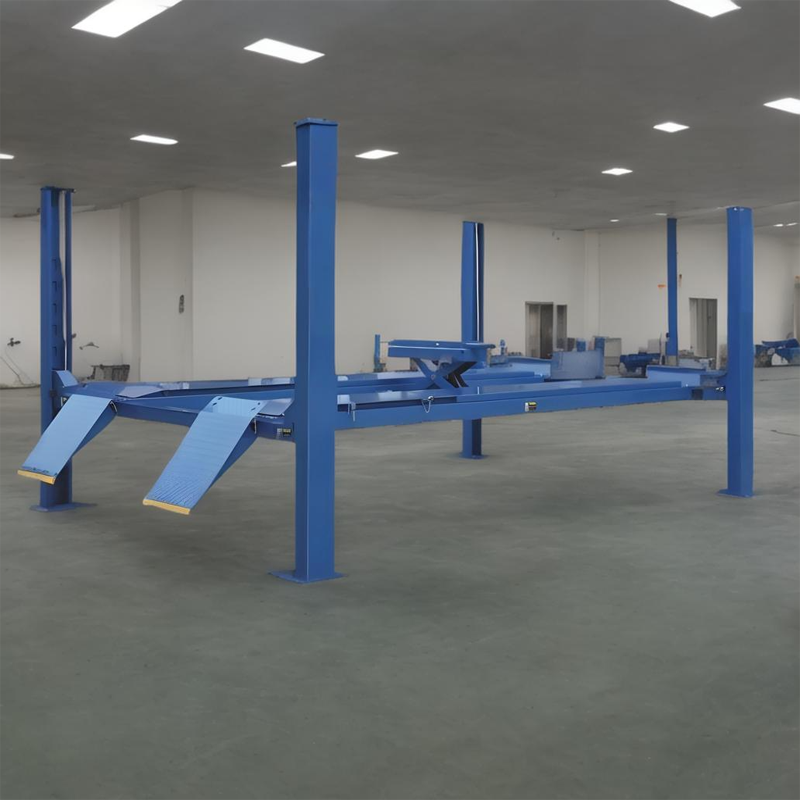Understanding Vehicle Lift Technologies in Modern Auto Shops
The backbone of any professional auto repair shop lies in its lifting equipment. Whether you're a seasoned mechanic or setting up your first garage, choosing between a scissor car lift and a two-post lift represents a crucial decision that impacts workflow efficiency, space utilization, and service capabilities. These two distinct lifting systems offer unique advantages and limitations that deserve careful consideration before making an investment.
Auto repair professionals worldwide rely on these lifting solutions daily, with each type serving specific needs and applications. The choice between them often determines not only the range of services a shop can offer but also influences workplace safety and operational costs. Let's explore these two popular lifting solutions in detail to help you make an informed decision for your automotive business.
Core Design and Operational Mechanisms
Scissor Car Lift Engineering
A scissor car lift operates through a sophisticated mechanical system that employs crossing steel supports forming an 'X' pattern. This design allows the lift to expand vertically while maintaining a stable base. The lifting mechanism typically relies on hydraulic power, with the scissoring action providing exceptional stability throughout the lifting range.
The unique engineering behind scissor lifts enables them to support weight evenly across their entire platform. This weight distribution makes them particularly suitable for vehicles with uneven weight distributions or modified suspensions. The lifting process is smooth and controlled, minimizing any potential vehicle movement during elevation.
Two-Post Lift Configuration
Two-post lifts feature vertical columns with adjustable arms that contact the vehicle at designated lifting points. These lifts utilize either a symmetric or asymmetric design, with the posts working in tandem to raise vehicles by their frame or designated lifting points. The system relies on powerful hydraulic cylinders housed within the columns.
The engineering focuses on maximizing access to the vehicle's underside while maintaining a relatively small footprint. The posts are anchored securely to the ground and often feature additional stabilization mechanisms to ensure safety during operation. This design has become an industry standard due to its versatility and reliability.

Space Requirements and Installation Considerations
Footprint and Ceiling Height Demands
The scissor car lift typically requires less floor space than its two-post counterpart, making it an attractive option for smaller garages or shops with limited square footage. However, these lifts need a completely flat surface for installation and operation. The compact design means they can often be installed in areas where space optimization is crucial.
Two-post lifts demand more floor space and specific ceiling height requirements to accommodate taller vehicles. The installation process involves precise measurements and concrete foundation requirements to ensure proper anchoring. While they require more initial space planning, they often provide better access around the lifted vehicle.
Installation Complexity and Requirements
Installing a scissor car lift generally involves less complexity, as many models can be surface-mounted or recessed into the floor. The primary consideration lies in ensuring the floor can support the load and maintaining a level surface. Some models offer portability options, adding flexibility to shop layout modifications.
Two-post lift installation demands more extensive preparation, including concrete depth verification and precise anchor bolt placement. The process requires professional installation to ensure proper alignment and secure anchoring. While more involved, this thoroughness contributes to long-term stability and safety.
Versatility and Vehicle Accessibility
Service Access Points
Scissor car lifts provide excellent access to vehicle undersides but may restrict side access due to their platform design. This configuration proves particularly beneficial for tire services, brake work, and general inspections. The full-length platform support ensures steady lifting for various vehicle types, from compact cars to light trucks.
Two-post lifts excel in providing unrestricted access to vehicle sides, wheels, and undercarriage components. This open design facilitates comprehensive service work, including suspension repairs, exhaust system maintenance, and drivetrain operations. Technicians can move freely around the vehicle, improving workflow efficiency.
Vehicle Type Compatibility
The scissor car lift demonstrates exceptional versatility in handling various vehicle weights and sizes within its rated capacity. The platform design accommodates vehicles with low ground clearance particularly well, making it ideal for sports cars and modified vehicles. Some models offer adjustable platforms to accommodate different wheelbases.
Two-post lifts show remarkable adaptability across a wide range of vehicles, from compact cars to heavy-duty trucks. The adjustable arms can be configured to lift vehicles safely regardless of their frame design or weight distribution. This flexibility makes them a popular choice for shops serving diverse customer bases.
Safety Features and Maintenance Requirements
Built-in Safety Systems
Modern scissor car lifts incorporate multiple safety features, including automatic locking mechanisms at various heights, overload protection systems, and emergency stop controls. The platform design inherently provides stability, with some models featuring additional cross-bracing for enhanced security during operation.
The safety systems in two-post lifts include automatic arm restraints, padded height limiters, and synchronized lifting mechanisms. These features ensure balanced lifting and prevent vehicle movement once elevated. Regular safety certification and inspection protocols help maintain optimal operating conditions.
Maintenance Protocols
Maintaining a scissor car lift involves regular inspection of hydraulic systems, lubrication of moving parts, and checking platform alignment. The relatively simple mechanical design often results in lower long-term maintenance costs. However, the enclosed nature of some components may require specialized service for repairs.
Two-post lifts require consistent attention to cable tension, hydraulic fluid levels, and arm restraint functionality. While maintenance procedures are straightforward, the exposed nature of components means more frequent visual inspections and adjustments may be necessary to ensure safe operation.
Frequently Asked Questions
What is the typical lifting capacity difference between scissor and two-post lifts?
Scissor car lifts typically offer lifting capacities ranging from 6,000 to 12,000 pounds, while two-post lifts commonly handle 7,000 to 18,000 pounds. The specific capacity depends on the model and manufacturer, with both types available in various weight ratings to suit different needs.
How do operating costs compare between these lift types?
Scissor lifts generally have lower initial installation costs and potentially reduced maintenance expenses due to their simpler design. Two-post lifts may require higher upfront investment for installation but often provide longer service life and greater versatility, potentially offering better long-term value despite higher initial costs.
Which lift type is better for limited space applications?
Scissor car lifts typically offer better space efficiency for facilities with limited floor area, as they have a smaller footprint when lowered and don't require permanent installation space around the lift. However, consider both your space constraints and service requirements when making the final decision.

